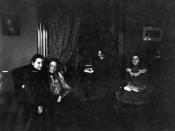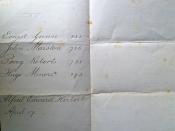In George Herbert's poem "The Collar," published in The Temple (1633), the author/persona rebels against the casuistry that the Christian life imposes, only to be brought back finally into childlike submission when he hears (or thinks he hears) the "Lord's" gentle rebuke. My argument is that, astoundingly, the poem's elaborate, random-seeming rhyme scheme--itself "collar-like" because it edges the poem--encodes witty messages that force us to rethink the poem's meaning, especially its serious tone.[1]
The discovery explicated here belongs originally to Cary Ader, a Miami-Dade Community College student who proposed it in 1992 to his professor, Norbert Artzt, who passed it on to me because he knew of my investigations into runic embeddings and "suppressed design" in earlier literature. In brief, Ader detected that if one uses conventional alphabetic analysis the complex rhyme scheme of the poem ends with a "NO NO!" that sounds like a playful echo of (and gloss on) the Lord's sotto voce reprimand in the last lines of the text itself.
My main contributions to Ader's findings are to propose that a second, concurrent rhyme scheme--inherent in the ambiguous phonics of the poem's endwords--yields further communication, and that the two letter codes themselves convey complex runic meanings, not just quippy one-liners.
Ader's analysis of the poem's rhyme scheme appears, (see poem page 74) in column A, mine in column B. The divergence arises from ambiguous rhyming relationships between endwords suit/fruit/dispute (lines 6, 9, 20) and drown it/crown it (12,14). As Ader correctly recognized, these endword sound groups are phonically remote; still, their "disputable" eye-rhyme linkage does permit my alternative construction. If allowed, the B rhyme scheme generates a terminal "MN MN"--a phonic string that puns insistently on "Amen! Amen!" Because "amens" conventionally close and underscore messages, these are inarguably relevant to Preacher Herbert's verse text.
To facilitate discussion, I have heightened several alphabetic strings with boldfaced type. Herbert's initial acrostic letterstring NOO (15,20-21,my emphasis) suggests that the other acrostic NO NO (33-36) that we "think we are hearing" is Herbert's authorized statement.
The whispered "No! No!" is an appropriately soft-spoken negation reprimanding a "child"; concurrently, the "Amen" is preacher talk--but not the usual shout--that affirms. Thus these juxtaposed end elements gain oxymoronic force, their witty relevance suggesting both tedious authorization and intentional duplicity.
Boldfaced strings (beginning with line 4) also heighten latent authorized letter strings that spell out BAD, DEAD, HID, and JIG--as well as a phonic version of "cabal" (KBLL) and some potential scatology (e.g., BM). A "jig"--with its playful "up-and-down" features--might also be a "joke," "trifle," or "trick" (1592) and thus a "dodge," "device," or "contrivance" (OED).
The likelihood that Herbert contrived duplicitous rhyme scheme wit in "The Collar" gains support from a parallel pattern that (following Ader's model) can be extrapolated from another of Herbert's poems, "Deniall"[3]--a stanzaic work in which "NO NOO" echoes the titular "negation":
Rhyme scheme Rhyme scheme
A B
pierce/eares/verse/fears/disorder A B A B C A B A B C
bow/asunder/go/thunder/alarms D C D C E D E D E F
say/benumme/day/come/hearing F G F G H G H G H I
tongue/thee/long/knee/hearing I J I J H J K J K I
sight/unstrung/right/hung/
Discontented K L K L M L M L M N
breast/time/request/chime/ryme N O N O O O P O P P
The rhyme scheme split as shown above, occurs because "asunder" may or may not rhyme with "disorder." This poem's rhymes are overtly playful because "disorder" is a "disorderly" nonrhyme and because "chime" and "ryme" do "chime and rhyme"--replacing disorder with formality. (The "odd-word" string reads, "Disorder alarms hearing--hearing discontented ryme.") "Ope up" (code . . . OP OPP) means "Discover." But "Nun 'O' "and" . . . leman / 'O' pop" (i.e., "mistress / ope up") are bawdy.
In "The Collar" (and thus elsewhere) it even seems to be true that Herbert contrived whole rhyme scheme letterstrings (if not rhyming-word strings) to encode sequential coterie humor. The phonic explorations in the following diagrams (a) and (b)--"playthroughs" of a literate game--show meaning of a sort that can be generated when clever authorial manipulation consorts with the playful nature of language itself:
(a) Rhyme Scheme A Codeline
ABC BAD E A D CEF GF HHD LJD JIG KKGL B MML B NON O
A busy body I deceive, give hid edged [aged] jig; cudgel be minimal, be none, O!
A busy bee--I--dead see, if gift, hid edged [aged] jig, cudgel. Be m' meal, be nun, O!
A busy bee eye did see . . . . . . adag'd jig, cage'll be . . . . . . Male 8, Nun O
A busy B.A. 'd aye [I/eye] deceive, give head, I judge. I giggle--be mammal, be none, O!
Though "NON" of the readings in (a) is conclusive, the idea that the poet's "hid edged [adaged] jig [i.e., device]" is a "cudgel" makes sense to any pummeled reader/player. Because "B" suggests "8," ML 8 NON 0 emerges as a "score" report, with the male coming out on top. Phallic and pudendal humor lurks here. Potentialities include "50 [= L] ate [= B = 8] male/meal, ate nun, O!"
(b) Rhyme Scheme B Codeline
ABC BAD EA DCEDFD GGD HID IH FJJ FK BLL K B MNMN
A busy body I deceived -- good idea . . . . bulky be minim. End.
"ABC" be a dead seed if digged. Hid, I fadge [bundle?], f -- k Bill, Kate -- m' end, m' end.
A busy B.A., dead . . . . . God hid I/eye/aye . . . . . key be "Amen, amen."
Naysayers will offer predictable objections to Ader's discovery and my own elaborations: (1) No known precedents exist; (2) Herbert may not have even used ABCs for rhyme scheme analysis; (3) the code readings are "farfetched," "not nice," and partly a reader/player's own inventions; no writer would have "meant" so much.
My rebuttals, briefly, are these: (1) Coterie activities are by definition secret and self-limiting; (2) I am unsure exactly when alphabetic analysis of rhymes was conventionalized, but using ABCs to show serial order is a common practice so old as to be undated in OED; and (3) I agree, without conceding the absence of authorization. The letter games that Herbert perpetrated (surely for a male in-group) are conventional code-string stimuli made to trigger responses in which author and reader together can create "meaning." (All author/ reader relationships are such, in fact.)
Cary Ader, I believe, has rediscovered an important lost paradigm, a generic literary game by which poets once communicated conventionally--and licentiously--with private readerships. Dr. Samuel Johnson, who condemned the "false wit" of shaped verses like Herbert's "The Altar" and "Easter-wings," probably also hated the "forced" irrationalities of writers' coterie games--if he knew of them.[4] Neoclassical tastes notwithstanding, Renaissance authors cherished sprezzatura, skillfully suppressed design of the sort advocated in Baldassare Castiglioni's The Courtier (1561). This ideal required that artful effort be hidden by apparant nonchalance--as in, for example, the ingeniously "random," formal irregularity of "The Collar." One notable, long-lost instance of sprezzatura is the elaborate substructure of numbers coyly undergirding Spenser's Epithalamion.[5] The fact that A. Kent Hieatt discovered this formal scheme only decades ago suggests that other early literary pieces may still be playing us for sober fools because we are reading them ingenuously, missing meaningful details and latent wit.
NOTES
1. I have previously addressed this subject in "Herbert's 'Double Pleasures': Suppressed Design and Rhyme Scheme Wit in 'The Collar,'" a paper presented at the South Central Conference on Christianity and Literature, Shreveport, Louisiana, 4 February 1994. See also my essay, "Suppressed Design in Shakespeare's Sonnets," in Upstart Crow 15 (1995), and my essay "Two Newfound Poems by Edmund Spenser," Spenser Studies VII (1987): 199-238. My other monographs on the subject of runic embedding (1977ff.) are available from The Paul Meek Library, The University of Tennessee at Martin, Martin, TN 38238, phone (901)587-7060. OCIC symbol THM, Fax (901)587-7074.
2. The Works of George Herbert, ed. F. E. Hutchinson (Oxford: Clarendon Press, 1964) 15354.
3. Works 79-80.
4. Works 26, 43. And see Johnson's often-reprinted Life of Abraham Cowley (1781).
5. See A. Kent Hieatt, Short Time's Endless Monument: The Symbolism of the Numbers in Edmund Spenser's "Epithalamion," (1960, Port Washington, NY: Kennikat Press, 1972).
The Collar
Rhyme Rhyme
scheme scheme
A B
I Struck the board, and cry'd, No more A A
I will abroad. B B
What? shall I ever sigh and pine? C C
My lines and life are free; free as the rode, B B
5 Loose as the winde, as large as store. A A
Shall I be still in suit? D D
Have I no harvest but a thorn E E
To let me bloud, and not restore A A
What I have lost with cordiall fruit? D D
10 Sure there was wine C C
Before my sighs did drie it: there was corn E E
Before my tears did drown it. F D
Is the yeare onely lost to me? G F
Have I no bayes to crown it? F D
15 No flowers, no garlands gay? all blasted? H G
All wasted? H G
Not so, my heart, but there is fruit, D D
And thou hast hands. I H
Recover all thy sigh-blown age J I
20 On double pleasures: leave thy cold dispute D D
Of what is fit, and not. Forsake thy cage, J I
Thy rope of sands, I H
Which pettie thoughts have made, and made to
thee G F
Good cable, to enforce and draw, K J
25 And be thy law, K --
While thou didst wink and wouldst not see. G F
Away; take heed: L K
I will abroad. B B
Call in thy deaths head there: tie up thy
fears M L
30 He that forbears M L
To suit and serve his need, L K
Deserves his load. B B
But as I rav'd and grew more fierce and wilde N M
At every word, O N
35 Me thoughts I heard one calling, Child! N M
And I reply'd, My Lord.[2] O N


